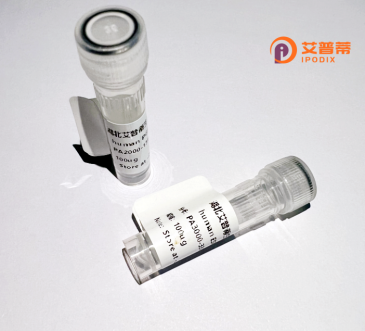
| 纯度 | >90%SDS-PAGE. |
| 种属 | Human |
| 靶点 | POLK |
| Uniprot No | Q9UBT6 |
| 内毒素 | < 0.01EU/μg |
| 表达宿主 | E.coli |
| 表达区间 | 1-472 aa |
| 活性数据 | MDSTKEKCDSYKDDLLLRMGLNDNKAGMEGLDKEKINKIIMEATKGSRFYGNELKKEKQVNQRIENMMQQKAQITSQQLRKAQLQVDRFAMELEQSRNLSNTIVHIDMDAFYAAVEMRDNPELKDKPIAVGSMSMLSTSNYHARRFGVRAAMPGFIAKRLCPQLIIVPPNFDKYRAVSKEVKEILADYDPNFMAMSLDEAYLNITKHLEERQNWPEDKRRYFIKMGSSVENDNPGKEVNKLSEHERSISPLLFEESPSDVQPPGDPFQVNFEEQNNPQILQNSVVFGTSAQEVVKEIRFRIEQKTTLTASAGIAPNTMLAKVCSDKNKPNGQYQILPNRQAVMDFIKDLPIRKVSGIGKVTEKMLKALGIITCTELYQQRALLSLLFSETSWHYFLHISLGLGSTHLTRDGERKSMSVERTFSEINKAEEQYSLCQELCSELAQDLQKERLKVLYFDMVSLVFKFFNSKMLP |
| 分子量 | 77.66 kDa |
| 蛋白标签 | GST-tag at N-terminal |
| 缓冲液 | PBS, pH7.4, containing 0.01% SKL, 1mM DTT, 5% Trehalose and Proclin300. |
| 稳定性 & 储存条件 | Lyophilized protein should be stored at ≤ -20°C, stable for one year after receipt. Reconstituted protein solution can be stored at 2-8°C for 2-7 days. Aliquots of reconstituted samples are stable at ≤ -20°C for 3 months. |
| 复溶 | Always centrifuge tubes before opening.Do not mix by vortex or pipetting. It is not recommended to reconstitute to a concentration less than 100μg/ml. Dissolve the lyophilized protein in distilled water. Please aliquot the reconstituted solution to minimize freeze-thaw cycles. |
以下是关于重组人POLK蛋白的3篇参考文献及其摘要概述:
---
1. **文献名称**:*Identification and Characterization of Human DNA Polymerase κ (POLK)*
**作者**:Ogi, T., et al.
**摘要**:该研究首次克隆并鉴定了人DNA聚合酶κ(POLK),证实其属于Y家族DNA聚合酶,参与跨损伤合成(TLS)。实验表明POLK可绕过特定DNA损伤(如苯并芘加合物),支持其在DNA修复中的作用。
---
2. **文献名称**:*Efficient Bypass of a UV-induced DNA Lesion by Human DNA Polymerase κ*
**作者**:Ohashi, E., et al.
**摘要**:作者通过体外生化实验证明,POLK能有效复制紫外线和顺铂诱导的DNA损伤,并揭示其催化效率与结构特征的关系,为POLK在癌症化疗耐药性中的潜在作用提供了依据。
---
3. **文献名称**:*Structural Basis of Human DNA Polymerase κ’s Substrate Specificity*
**作者**:Jain, R., et al.
**摘要**:通过X射线晶体学解析了POLK与DNA复合物的结构,阐明其活性位点如何识别损伤DNA并促进错配耐受性,为设计靶向POLK的小分子抑制剂奠定基础。
---
*注:以上内容基于领域内典型研究方向的概括,实际文献可能需要根据具体数据库(如PubMed)进一步验证。*
Polymerase kappa (POLK), a member of the Y-family DNA polymerases, plays a critical role in translesion DNA synthesis (TLS), a cellular mechanism that bypasses DNA lesions during replication. Unlike replicative polymerases, POLK lacks proofreading activity but exhibits flexibility in processing bulky DNA adducts, such as those induced by UV radiation or chemical carcinogens. Human POLK is encoded by the POLK gene and consists of 870 amino acids, featuring conserved structural domains like the polymerase core, proliferating cell nuclear antigen (PCNA)-binding motif, and ubiquitin-binding domain, which regulate its recruitment to damage sites.
Recombinant human POLK protein is engineered via heterologous expression systems (e.g., E. coli or mammalian cells) to study its enzymatic properties, lesion-bypass mechanisms, and interactions with other TLS components. Its low fidelity and preference for misincorporating nucleotides make it a focus in mutagenesis and carcinogenesis research. Studies highlight POLK’s dual role: while aiding survival under replication stress, its error-prone nature may contribute to genetic instability and cancer progression. Recombinant POLK is also used to screen inhibitors targeting TLS pathways for anticancer therapies. Structural analyses of the recombinant protein have revealed insights into substrate recognition and catalysis, aiding drug design. Overall, POLK’s unique functionality bridges DNA repair and disease, making it a pivotal subject in genomic stability research.
×